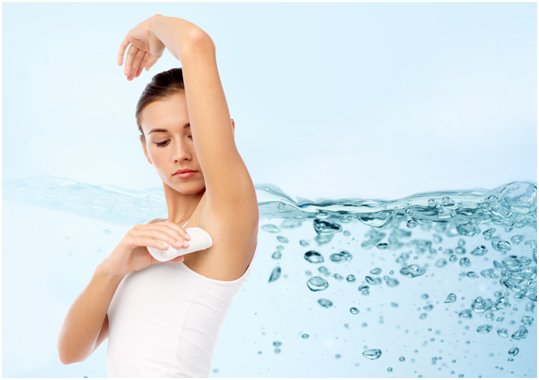Q: What’s the difference between an underarm antiperspirant and a deodorant?
In 1984, the Gillette Company launched one of the most successful advertising campaigns ever created, making its Dry Idea® antiperspirant a household name.
Using popular celebrities including a fashion designer, actress, comedian and NFL football head coach, each advertisement featured an individual who shared three pieces of “advice” with their audience, each one starting with the word “Never…” The first two “neverisms” were related to their profession, and the third one was always the same, a tag line created just for Gillette’s Dry Idea® marketing: “Never Let Them See You Sweat”.
Sweat happens. The average adult makes between 0.5 and 1.5 liters of sweat every day. Created inside special glands called sweat glands, sweat is delivered to the skin through tiny tubes called sweat ducts.
Humans have 2 types of sweat glands: eccrine glands that are active from birth, and apocrine glands, which don’t become active until puberty. The sweat from eccrine glands is odorless and nearly 100% water, while apocrine glands secrete a thicker, oily substance with a musky scent.
Sweat glands concentrate in certain areas, including your forehead and temples, your armpits, the palms of your hands and the soles of your feet. Although you have far more eccrine sweat glands than scent-producing apocrine glands, both can be triggered by either excessive body temperature or the stress of anxiety, fear, or pain.
Although the sweat from your eccrine glands is odorless when secreted, it creates an odor when the bacteria that live on your skin digest it. Eccrine sweat also makes the smellier sweat from your apocrine glands much more noticeable.
There are 4 ways you can combat the body odor and wetness created by sweating. The first way is by using good hygiene like showering or bathing regularly, which removes both types of sweat deposited on your skin before it can be digested by bacteria, and also reduces the number of bacteria on your skin available to digest it.
You can also block perspiration from landing on your skin by applying an antiperspirant product to the areas that have the most sweat glands, like your underarms.
Two other ways to prevent development of body odor from sweat include inhibiting bacterial digestion of the sweat already on your skin by applying an antimicrobial, and by using a fragrance to offset body odor.
All topical antiperspirants are compounds called astringents. When applied to the skin, astringents cause proteins on your skin cells to clump up. This clumping action blocks the sweat ducts on your skin, keeping that particular area of skin more dry. Since astringents also work as antimicrobials by interfering with the bacteria living on your skin, all antiperspirants also work as deodorants.
Most antiperspirants contain salts of aluminum, either alone or in combination with zinc. The most desirable antiperspirants keep skin dry without caking or flaking off, damaging fabrics, or causing skin irritation. The most common antiperspirant ingredients used today are aluminum zirconium, aluminum chloride, and aluminum sulfate, also called alum.
Because of the increased concentration of aluminum in the brains of people with Alzheimer’s dementia, there is concern that daily use of antiperspirants containing aluminum could increase your risk of developing Alzheimer’s. You can minimize your exposure to aluminum by using a deodorant-only product or a “natural” antiperspirant that does not contain alum or aluminum salts.
Underarm deodorants without antiperspirants are antimicrobial compounds capable of interfering with the digestion of sweat by bacteria on your skin. Vitamin E and benzalkonium chloride are the most common antimicrobials used in underarm deodorants.
Benzalkonium chloride is a mild astringent and antimicrobial agent widely used in products for skin and mucous membranes and also as a preservative commonly used in contact lens solutions and nonprescription eye drops.
Here are 3 Tips for Choosing an Underarm Antiperspirant and Deodorant:
- Choose between an antiperspirant/deodorant or deodorant only product.
I often use just a deodorant because while antiperspirants keep my armpits dry, it sometimes backfires with my entire back becoming totally soaked in sweat.
- Make your choice based on what scent you like, not by your gender.
The strength and chemical composition of underarm antiperspirant/deodorant products is identical for those marketed for men and women. The only difference between them is the fragrance used.
- There are stronger antiperspirant products available without a prescription.
You can use a “clinical strength” antiperspirant product which contains 20% aluminum zirconium instead of the typical 15%, or try the non-prescription antiperspirant Drysol®, which contains 20% aluminum chloride hexahydrate in concentrated ethyl alcohol.


